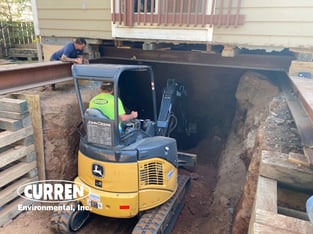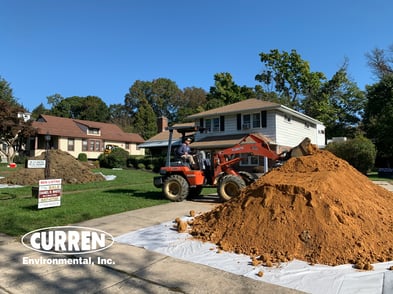Many clients come to Curren after purchasing a property and now have an issue with an oil tank. Before purchasing any property, you need to know if the oil tank is LEAKING. This is the most important piece of information you need in regard to an oil tank. The only way to know if your oil tank is leaking into the soil, and to prove it to anyone, including a mortgage company, insurance company, bank, or a local/state governing body is by soil sampling. It is impossible to know if the oil tank has leaked by smell and/or sight, you need the soil analyzed by a certified laboratory for your state's required analysis.
 A lot of buyers will accept, “the oil tank was properly closed in place”. Yes, that may certainly have been true of what happened at one time. However, today, regulations have changed and again the most important thing to know is if the oil tank is LEAKING. Many oil tanks are abandoned in place, 10, 20, or 30 years ago. Back in the day, less than 1% of the time soil samples were acquired to see if the oil tank leaked. Additionally, the method of filling the oil tank in place varies greatly. Standard operating procedures today are to cut a hole in the oil tank, large enough for a person to fit in the oil tank, and clean out the oil tank before filling it in place. Nine times out of ten, a hole has not been cut large enough for someone to fit into and the oil tank has not been properly cleaned. If the oil tank was not properly cleaned, the oil and sludge left behind are now comingled with the material filling the oil tank. That material is now contaminated. Cutting a hole in the top of the oil tank now provides a very easy way for rainwater to get into the oil tank. Over the years the rainwater not only corrodes the bottom of the oil tank but can fill up the oil tank and any leftover oil or sludge can rise to the top, overflow, and contaminate the soil at the bottom. The water can also corrode the bottom of the oil tank and the oil and sludge can contaminate the soils beneath it.
A lot of buyers will accept, “the oil tank was properly closed in place”. Yes, that may certainly have been true of what happened at one time. However, today, regulations have changed and again the most important thing to know is if the oil tank is LEAKING. Many oil tanks are abandoned in place, 10, 20, or 30 years ago. Back in the day, less than 1% of the time soil samples were acquired to see if the oil tank leaked. Additionally, the method of filling the oil tank in place varies greatly. Standard operating procedures today are to cut a hole in the oil tank, large enough for a person to fit in the oil tank, and clean out the oil tank before filling it in place. Nine times out of ten, a hole has not been cut large enough for someone to fit into and the oil tank has not been properly cleaned. If the oil tank was not properly cleaned, the oil and sludge left behind are now comingled with the material filling the oil tank. That material is now contaminated. Cutting a hole in the top of the oil tank now provides a very easy way for rainwater to get into the oil tank. Over the years the rainwater not only corrodes the bottom of the oil tank but can fill up the oil tank and any leftover oil or sludge can rise to the top, overflow, and contaminate the soil at the bottom. The water can also corrode the bottom of the oil tank and the oil and sludge can contaminate the soils beneath it.
 If you are looking to buy a house and cannot confirm the heat source throughout the legacy of the house, you may want to perform a Ground Penetrating Radar (GPR) to determine if an underground oil tank was present. Once you own the home, you own the problem and today completing a GPR as well as a home inspection leads homeowners to uncover oil tanks that had been abandoned in place that they were never made aware of before they purchased the house. Now they want to sell but have to deal with the underground oil tank. Once the oil tank is abandoned the fill port and vent pipe can be cut off and no evidence of the oil tank would be on the ground surface. Two copper lines that feed the heater could be identified in the basement or crawl space by the inspector which is a telltale sign of a former oil tank. Additionally, if there is an aboveground oil tank in the basement, there is a good chance depending on the age of the oil tank in the basement, a oil tank could be buried underground.
If you are looking to buy a house and cannot confirm the heat source throughout the legacy of the house, you may want to perform a Ground Penetrating Radar (GPR) to determine if an underground oil tank was present. Once you own the home, you own the problem and today completing a GPR as well as a home inspection leads homeowners to uncover oil tanks that had been abandoned in place that they were never made aware of before they purchased the house. Now they want to sell but have to deal with the underground oil tank. Once the oil tank is abandoned the fill port and vent pipe can be cut off and no evidence of the oil tank would be on the ground surface. Two copper lines that feed the heater could be identified in the basement or crawl space by the inspector which is a telltale sign of a former oil tank. Additionally, if there is an aboveground oil tank in the basement, there is a good chance depending on the age of the oil tank in the basement, a oil tank could be buried underground.
The best approach is to ensure that if there was an abandoned oil tank on the property you either get proper documentation the oil tank did not leak or remove the oil tank before buying the property.

